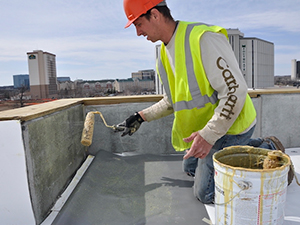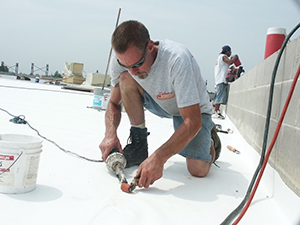
Commercial roofing systems play a crucial role in protecting businesses, warehouses, retail spaces, and industrial buildings from the elements. A well-designed and professionally installed roof not only safeguards your structure but also helps reduce energy costs and extend the lifespan of your building. This article provides an overview of the diverse types of commercial roofing systems and their benefits. If you need a professional team to manage your roofing systems, contact Golden Eagle Roofing in Holmen, WI at (608) 633-6719.
Types of Commercial Roofing Systems
Flat Roofing Systems: Flat roofs are common in commercial buildings because they are cost-effective and easy to maintain. They are covered with a membrane, such as TPO (Thermoplastic Olefin), EPDM (Ethylene Propylene Diene Monomer), or modified bitumen. Flat roofs are ideal for buildings with a modern, minimalist design, as they offer space for HVAC units, solar panels, or even rooftop gardens.
Single-Ply Roofing: Single-ply roofing membranes are a popular choice for commercial structures due to their durability and ease of installation. These roofs are typically made from materials like TPO, PVC, or EPDM. Single-ply systems are lightweight, flexible, and highly resistant to weather elements such as wind, rain, and UV rays. They are also energy-efficient, as some membranes come with reflective coatings that reduce heat absorption.
Built-Up Roofing (BUR): Built-up roofing consists of multiple layers of roofing felt, bitumen, and gravel or a similar protective layer. Known for its strength and durability, BUR is often used for low-slope roofs. The multiple layers create a robust barrier against water, making it ideal for areas that experience heavy rainfall or snow. BUR systems also have excellent insulation properties, making them energy efficient.
Metal Roofing: Metal roofing is a versatile and long-lasting option for commercial properties. It can be made from materials such as steel, aluminum, or copper. Metal roofs are resistant to corrosion, fire, and extreme weather conditions, including high winds and hail. Additionally, metal roofs can be insulated to improve energy efficiency and reduce heating and cooling costs.
Key Considerations

When choosing a roofing system, building owners must consider factors such as the building’s location, climate, budget, and intended use. Proper installation and regular maintenance are essential to ensure the roof performs effectively and lasts its full lifespan. Working with a professional roofing contractor is critical to making an informed decision and securing a high-quality, long-lasting roofing system.
Commercial Roofing Systems Expert
In conclusion, selecting the right commercial roofing system is essential for ensuring building durability, energy efficiency, and long-term performance. With a wide range of options available, it’s important to evaluate the benefits of each system to determine the best fit for your business needs. For expert roofing systems, contact Golden Eagle Roofing in Holmen, WI at (608) 633-6719.
FAQ
What is the most common commercial roofing system?
The most common commercial roofing systems are flat roofing systems, particularly single-ply membranes like TPO, EPDM, and PVC. These systems are popular due to their cost-effectiveness, ease of installation, and durability, making them ideal for many commercial buildings.
Can a commercial roof be repaired, or does it need to be replaced?
Many commercial roofs can be repaired, especially if the damage is localized or caused by wear and tear. However, if the roof is significantly damaged, aging, or experiencing frequent issues, it may be more cost-effective to replace the roof. A professional roofing contractor can assess the condition of the roof and recommend the best course of action.
Are commercial roofs energy-efficient?
Yes, many modern commercial roofing systems are designed with energy efficiency in mind. For example, reflective single-ply membranes, metal roofing, and green roofs can help reduce heat absorption, keeping the building cooler in summer and reducing the need for air conditioning. Proper insulation also plays a significant role in reducing heating and cooling costs.
How do I maintain a commercial roof?
Regular maintenance of a commercial roof includes inspecting damage, checking drainage systems for blockages, and cleaning debris from the roof. Ensuring that seams, flashing, and joints are intact is essential to prevent leaks. It is also important to schedule professional inspections and maintenance at least once or twice a year to identify potential issues before they become major problems.
